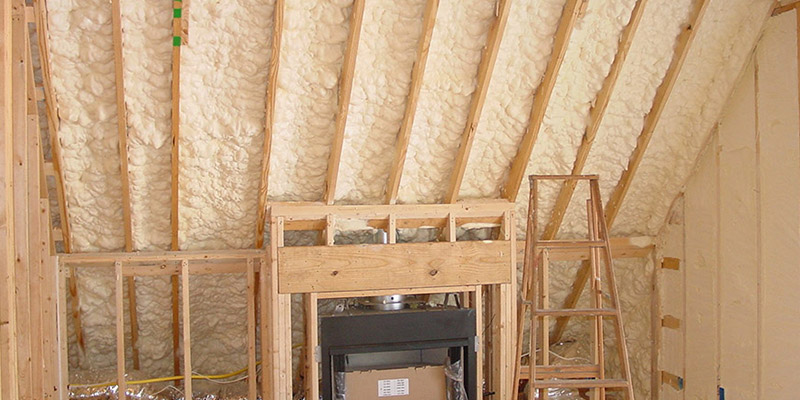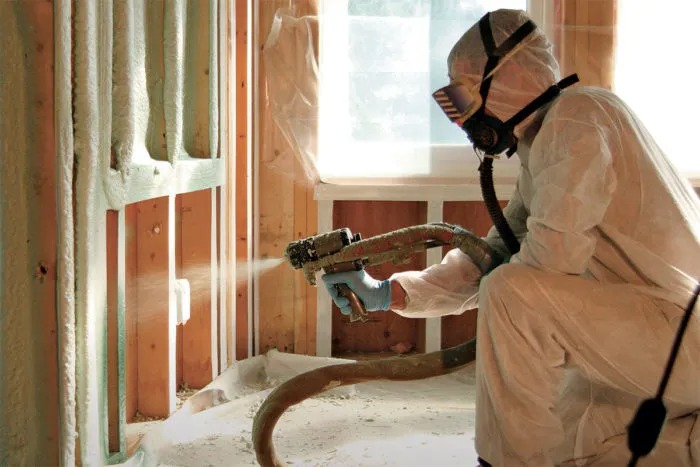Builders prefer closed-cell spray foam for long-term value because it offers insulation, structural strength, moisture control, and air sealing in a single application. This combination reduces energy costs, increases building durability, and minimizes long-term maintenance—leading to overall lifecycle savings.
Closed-cell spray foam forms a dense, rigid barrier once applied, providing high R-values and superior moisture resistance. It bonds directly to substrates, making it a reliable choice in areas with potential air leaks, thermal bridging, or water intrusion. Its performance is well-suited for both residential and commercial construction that prioritizes energy efficiency and durability.
Key Advantages for Long-Term Value
High Insulation Value and Moisture Control
Closed-cell spray foam insulation delivers an R-value between 6.0 and 7.0 per inch, making it one of the most efficient insulation materials. Its cellular structure reduces thermal transfer and resists water absorption. This dual functionality reduces the need for separate insulation and vapor barriers.
In walls, roofs, and floors, it prevents warm indoor air from escaping during winter and blocks heat and humidity during summer. In regions with high humidity or flood risk, its moisture-repelling quality helps protect structural materials from rot and mold.
Structural Strength and Application Versatility
With a compressive strength of 25 psi or more, closed-cell foam enhances structural integrity. It improves wall racking strength and resists shifting and sagging. Builders apply it in wall cavities, rim joists, under slabs, and ceilings to stabilize the building envelope while insulating.

Comparison With Other Insulation Options
| Feature | Closed-Cell Spray Foam | Open-Cell Spray Foam | Fiberglass Batt | Rigid Foam Board |
| R-Value per Inch | 6.0–7.0 | 3.5–4.0 | 2.9–3.8 | 4.5–5.0 |
| Moisture Resistance | High | Low | Low | High |
| Vapor Barrier | Yes | No | No | Optional |
| Air Sealing | Excellent | Moderate | Poor | Moderate |
| Compressive Strength (psi) | 25+ | <5 | Not applicable | 15–25 |
| Lifespan | 30–50 years | 20–30 years | 10–25 years | 20–40 years |
| Mold Resistance | Yes | Moderate | Low | Moderate |
| Installation Complexity | High | Medium | Low | Medium |
| Upfront Cost | High | Moderate | Low | Moderate |
Bonus Tip: In hybrid systems, builders pair closed-cell foam with other materials—like fiberglass—to cut costs while improving performance in key zones (rim joists, attics, crawl spaces).
Technical Performance Specifications
| Property | Closed-Cell Spray Foam |
| R-Value (per inch) | 6.0–7.0 |
| Density | ~2.0 lbs/ft³ |
| Water Absorption | <1% |
| Compressive Strength | ≥25 psi |
| Air Permeability | <0.02 L/s·m² |
| Water Vapor Transmission | ≤1 perm |
| Flame Spread Index (ASTM E84) | ≤25 |
| Expansion Rate | 30–60x |
| Service Temperature Range | -40°F to 180°F |
| Thermal Drift (20+ years) | Minimal (<5%) |

Market Data and Building Trends
Closed-cell spray foam use has grown steadily, especially in high-performance buildings. According to Allied Market Research, the global spray foam market is projected to reach $11.5 billion by 2031, driven largely by closed-cell applications in energy-conscious construction.
The U.S. Department of Energy identifies spray foam as a preferred solution for achieving net-zero energy goals. In cold climates, buildings with closed-cell insulation in roofs and walls report 35% lower heating energy use compared to those with fiberglass or cellulose.
Bonus Tip: Builders aiming for ENERGY STAR® or LEED certifications often choose closed-cell spray foam in walls and attics for its combined thermal and air barrier performance.
Practical Uses in Construction
Crawl Spaces and Basements
Closed-cell spray foam resists moisture intrusion and air infiltration in below-grade spaces. This helps control indoor humidity and prevent foundation wall deterioration.
Roof Decks and Attics
It is applied directly to roof decks to maintain conditioned attic spaces. Builders use it in cathedral ceilings or under sheathing to minimize heat gain and condensation issues.
Pole Barns and Metal Buildings
Metal-framed buildings often suffer from condensation and air leaks. Closed-cell foam addresses both by insulating and sealing metal seams, improving indoor comfort and protecting stored equipment or inventory.
Things to Consider Before Making a Decision
- Initial Investment: Closed-cell foam can cost 2–3 times more than fiberglass per square foot. Consider total lifecycle costs, including energy savings and maintenance reductions.
- Code Compliance: Some applications require ignition barriers or thermal covers. Verify local codes for exposed foam in basements, garages, or attics.
- Installation Conditions: Closed-cell foam requires specific temperature and moisture levels during installation to cure properly. Poor application affects performance.
- Thickness Requirements: Achieving high R-values may require multiple passes. In narrow cavities, consider whether there’s adequate space for desired thickness.
Common Questions
Is closed-cell spray foam a vapor barrier?
Yes. Closed-cell foam has a perm rating of ≤1, which meets vapor barrier requirements in most climates. It helps prevent moisture migration through walls and roofs.
Can it be applied to existing walls?
Yes, but access is limited. Builders may need to remove drywall or apply from the exterior. Retrofits require careful assessment to avoid trapping moisture inside walls.
Does it work in hot and cold climates?
Yes. Its thermal resistance and air-sealing abilities perform well across climate zones. It reduces both heating and cooling loads and keeps interior conditions stable.
Can it be used with other insulation?
Yes. Builders often combine closed-cell foam in high-risk areas (rim joists, rooflines) with fiberglass or cellulose in open wall cavities to reduce costs while maintaining performance.
Why Builders Prefer Closed-Cell Spray Foam for Long-Term Value FAQ
Why do builders choose closed-cell foam over open-cell for exterior walls?
Closed-cell foam has higher insulation value, moisture resistance, and strength. It’s more suitable for environments where air and water control are critical.
How long does closed-cell spray foam last?
Properly installed, closed-cell foam can last 30–50 years or more without sagging or degrading, maintaining its air seal and insulation properties over time.
Can closed-cell foam replace a vapor barrier?
Yes. In most cases, closed-cell foam functions as both insulation and a vapor control layer, eliminating the need for additional plastic barriers.
Is there any shrinkage or movement over time?
Closed-cell foam remains dimensionally stable after curing. When installed correctly, it adheres to surfaces and stays intact through seasonal changes.
Does the higher cost justify the investment?
Yes, for many builders. The long-term energy savings, moisture protection, and reduced callbacks make it a practical investment, especially in high-performance or custom builds.
Make the Right Decision
Builders consistently choose closed-cell spray foam because it offers long-term returns that other insulation types can’t match. It insulates, seals, and protects—helping buildings perform better and last longer. Before committing, assess your project needs, climate conditions, and future maintenance goals.
[Image: Closed-cell spray foam applied to underside of roof deck in residential attic space]
Reviewer:
Grace Walker has been in the spray foam business for 9 years and provided suggestions that helped refine this article’s focus on brand development and simple, consistent marketing efforts.





